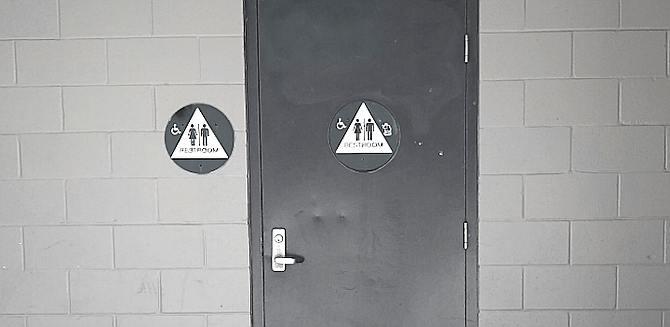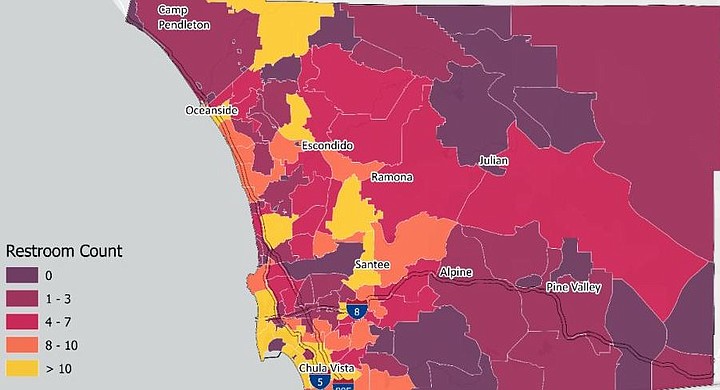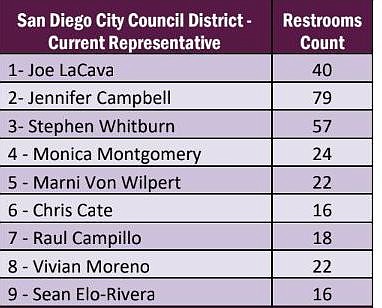 Facebook
Facebook
 X
X
 Instagram
Instagram
 TikTok
TikTok
 Youtube
Youtube

Call it a bathroom desert. Nearly half the county's census tracts have no permanent public restrooms. At the same time, using the great outdoors in lieu of a loo could lead to a fine.
The shortfall affects everyone from joggers and tourists to transit users but it's especially hard on those with physical disabilities and the homeless, say researchers with San Diego State's Project for Sanitation Justice.
At night, the expected ratio downtown is one restroom for every 383 unsheltered people.

The problem isn't unique to San Diego, but it's festered for more than two decades, prompting four county grand jury reports that warn about an outbreak of infectious disease due to the lack of facilities.
While the county brought in more toilets and handwashing stations during the shigella and hepatitis A outbreaks, many had already been whisked away when Covid-19 struck. During the pandemic, many permanent facilities closed entirely or cut their hours.
The region's public restrooms are managed by public agencies and public-private partnerships, plus departments within San Diego County’s 18 cities, the county, and the Port of San Diego. Until now, only portable units have been mapped.
Without knowing where the permanent bathrooms are - and aren't - it's hard to fix the problem, the researchers say. In a new report, they kick off with the first countywide database to nail down their locations.
To be included, a restroom had to be permanent, free of charge, and not located inside a private business or beyond a security screening checkpoint, like an airport.
The initial phase of the project aimed to home in on every last permanent public bathroom, slicing the data by jurisdictions, zip codes, census tracts, and the city's community planning areas and council districts.

"We have identified parts of our County that may be in urgent need of attention," the report reads.
They found a total of 669 public restrooms within the county – and gaps galore. There were 23 zip codes without a single public restroom. And there's the "astonishing" finding that 49 percent of census tracts have none, despite being home to about forty percent of the county's population.
Another 1,027,122 people live in tracts with one restroom and 403,011 people have two restrooms in their tract.
Solana Beach, Del Mar, Lemon Grove, Vista, and Imperial Beach have fewer than 10 each. The county's smaller cities average about 17 public restrooms each.
The Port of San Diego oversees 21 restrooms, included in the counts for Chula Vista, Coronado, Imperial Beach, National City, and San Diego.
Across the county's 113 zip codes, the average number is about six. By county district, the report found district 4 (Fletcher) to have the fewest, and district 3 (Lawson-Remer) the most.
The city of San Diego has 294 public restrooms. The average number for its nine council districts is about 33, though some have fewer than 20 (districts 6, 7, and 9), and two are "far above the average" (districts 2 and 3).
When it comes to community planning areas, Mission Bay Park leads with 40, downtown San Diego is next with 32, and Balboa Park has 21.
It remains unclear just how many restrooms are needed, but the researchers say there aren't nearly enough. In some cases, expanding hours and maintaining existing bathrooms would go a long way.
As the project continues over the next several months, they'll complete an audit of restroom quality and access, conduct surveys, and try to better understand community concerns about crime, vandalism, and the cost of maintenance.
Although the restrooms were counted between October 2021 and January 2022, it's not too late to add one that may have been missed, has permanently closed, or is under construction.


Call it a bathroom desert. Nearly half the county's census tracts have no permanent public restrooms. At the same time, using the great outdoors in lieu of a loo could lead to a fine.
The shortfall affects everyone from joggers and tourists to transit users but it's especially hard on those with physical disabilities and the homeless, say researchers with San Diego State's Project for Sanitation Justice.
At night, the expected ratio downtown is one restroom for every 383 unsheltered people.

The problem isn't unique to San Diego, but it's festered for more than two decades, prompting four county grand jury reports that warn about an outbreak of infectious disease due to the lack of facilities.
While the county brought in more toilets and handwashing stations during the shigella and hepatitis A outbreaks, many had already been whisked away when Covid-19 struck. During the pandemic, many permanent facilities closed entirely or cut their hours.
The region's public restrooms are managed by public agencies and public-private partnerships, plus departments within San Diego County’s 18 cities, the county, and the Port of San Diego. Until now, only portable units have been mapped.
Without knowing where the permanent bathrooms are - and aren't - it's hard to fix the problem, the researchers say. In a new report, they kick off with the first countywide database to nail down their locations.
To be included, a restroom had to be permanent, free of charge, and not located inside a private business or beyond a security screening checkpoint, like an airport.
The initial phase of the project aimed to home in on every last permanent public bathroom, slicing the data by jurisdictions, zip codes, census tracts, and the city's community planning areas and council districts.

"We have identified parts of our County that may be in urgent need of attention," the report reads.
They found a total of 669 public restrooms within the county – and gaps galore. There were 23 zip codes without a single public restroom. And there's the "astonishing" finding that 49 percent of census tracts have none, despite being home to about forty percent of the county's population.
Another 1,027,122 people live in tracts with one restroom and 403,011 people have two restrooms in their tract.
Solana Beach, Del Mar, Lemon Grove, Vista, and Imperial Beach have fewer than 10 each. The county's smaller cities average about 17 public restrooms each.
The Port of San Diego oversees 21 restrooms, included in the counts for Chula Vista, Coronado, Imperial Beach, National City, and San Diego.
Across the county's 113 zip codes, the average number is about six. By county district, the report found district 4 (Fletcher) to have the fewest, and district 3 (Lawson-Remer) the most.
The city of San Diego has 294 public restrooms. The average number for its nine council districts is about 33, though some have fewer than 20 (districts 6, 7, and 9), and two are "far above the average" (districts 2 and 3).
When it comes to community planning areas, Mission Bay Park leads with 40, downtown San Diego is next with 32, and Balboa Park has 21.
It remains unclear just how many restrooms are needed, but the researchers say there aren't nearly enough. In some cases, expanding hours and maintaining existing bathrooms would go a long way.
As the project continues over the next several months, they'll complete an audit of restroom quality and access, conduct surveys, and try to better understand community concerns about crime, vandalism, and the cost of maintenance.
Although the restrooms were counted between October 2021 and January 2022, it's not too late to add one that may have been missed, has permanently closed, or is under construction.
Comments